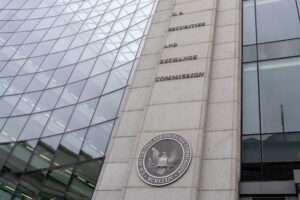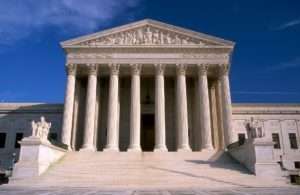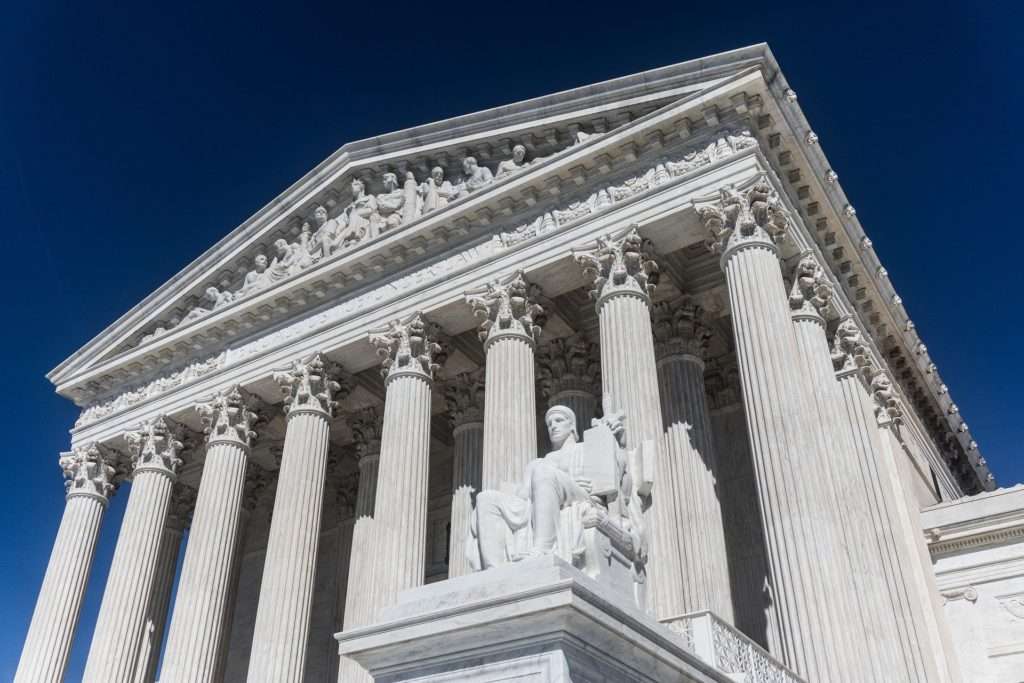Published August 5, 2024
By Patrick Boyle, Corporate Accountability Attorney at the Center for International Environmental Law, and Charles Slidders, Senior Attorney, Financial Strategies at the Center for International Environmental Law.
The US Supreme Court recently issued decisions in four cases that could profoundly weaken the administrative state, foreshadowing widespread dysfunction for federal agencies and the vast regulatory regimes they oversee, including federal protections safeguarding public health and the environment.
The US federal government has more than 439 agencies and subagencies, each with its own sphere of responsibility and expertise. These agencies are responsible for implementing, applying, and enforcing a wide array of regulations across areas such as air quality, clean drinking water, education, energy, financial markets, food safety, and healthcare — regulations that greatly impact American lives.
These Supreme Court decisions will undoubtedly be used to restrict the ability of federal agencies to interpret, apply, and enforce the laws and regulations crucial to the real-life, day-to-day implementation of our federal government’s most important functions.
Supreme Court Decisions Impacting Federal Agencies
The Supreme Court issued four decisions this past term (2023-2024) that challenge the authority of federal agencies:
- Loper Bright Enterprises v. Raimondo: Overturned the longstanding Chevron doctrine, which gave deference to federal agencies. Courts will no longer be required to defer to the specialized technical expertise of federal agencies and their reasonable interpretation of ambiguous statutory terms or unclear definitions provided by Congress.
- SEC v. Jarkesy: Ruled that the Securities and Exchange Commission (SEC) must provide defendants with a jury trial in enforcement actions seeking civil penalties, limiting the agency’s anti-fraud enforcement capabilities.
- Corner Post v. Federal Reserve: Extends the statute of limitations for challenges to agency actions, leading to prolonged legal uncertainty, even for decades-old regulations.
- Ohio v. EPA: Halted enforcement of the Environmental Protection Agency’s (EPA) “Good Neighbor” rule — which aimed to implement ozone air pollution standards — because the agency had not provided an adequate explanation of its plan. This case signals the Supreme Court’s willingness to hinder federal agency efforts to regulate pollution on a nationwide basis.
Chevron Deference and Its Demise
The advent of the doctrine of Chevron deference, established in 1984 through Chevron. v. NRDC, and its demise in Loper Bright Enterprises v. Raimondo both concern environmental regulation.
Chevron v. NRDC addressed the EPA’s interpretation and application of a regulation promulgated under the Clean Air Act. The Supreme Court upheld the EPA’s interpretation of an ambiguous provision of the law and, in doing so, held that courts must defer to an agency’s reasonable interpretation of ambiguous statutory terms — enter “Chevron deference.” For the past forty years, Chevron deference has been the cornerstone of administrative law, and Chevron v. NRDC has been cited no less than 18,000 times in other court decisions.
The Supreme Court’s decision in Loper Bright Enterprises v. Raimondo abruptly ended Chevron deference, significantly shifting power from federal agencies to the judiciary. The case concerned the regulation of the commercial fishing of overfished Atlantic herring pursuant to the Magnuson-Stevens Fishery Conservation and Management Act. The Supreme Court considered the narrow question of whether commercial fishers of Atlantic herring can be made to shoulder the cost of hosting government fisheries monitors on board their vessels.
In its decision, the Supreme Court ruled that courts — not agencies — are to determine all questions of law, including the single best interpretation of ambiguous terms, even if those terms are scientific and technical. Justice Elena Kagan’s dissent warned that the majority decision would leave courts to determine questions far outside their expertise, including issues of environmental protection, such as how to define a “distinct population segment” of endangered “vertebrate fish or wildlife” pursuant to the Endangered Species Act.
Shifts in Power and Ongoing Impact
The removal of Chevron deference fundamentally shifts power from Congress and the executive to the judicial branch. By upsetting the long-held equilibrium stewarded by the Chevron doctrine, Loper Bright Enterprises v. Raimondo will restrict the federal government’s operations and hinder environmental regulation.
Presidents depend on the administrative state to apply their policy preferences, and Congress enacts statutes with the understanding that agencies will utilize their experience and expertise to reasonably interpret ambiguities. Without Chevron deference, the Supreme Court will have the final say over policy questions and, in the words of Justice Kagan, becomes the country’s self-appointed “administrative czar.”
Loper Bright Enterprises v. Raimondo is already having a profound impact: as of August 5, 2024, fifty-nine courts have cited the decision, and litigants in 120 other cases have cited it in court filings. The decision is being used to stymie ESG investment regulation, reopen federal waters after an emergency closure to protect North Atlantic right whales, contest solar power facility certifications as a qualifying source of alternative energy, challenge requirements for water heaters to meet efficiency standards, and defend against the use of a tire manufacturing chemical whose runoff caused a “taking” of protected fish species.
Not only does Loper Bright Enterprises v. Raimondo present a serious obstacle to the application and interpretation of federal environmental protection rules, but, together with SEC v. Jarkesy, it will also limit the ability of agencies to enforce those rules.
Climate Disclosure Rules and ESG Investing after Loper Bright Enterprises v. Raimondo and SEC v. Jarkesy
Loper Bright Enterprises v. Raimondo and SEC v. Jarkesy will influence the ongoing challenge to the SEC’s Climate Disclosure Rules, currently pending before the Eighth Circuit Court of Appeals. The SEC’s Climate Disclosure Rules — albeit insipid — require larger companies to disclose material Scope 1 (direct) and Scope 2 (indirect) emissions information. These rules have been challenged by twenty-five states, two Big Oil trade groups, and the US Chamber of Commerce.
The primary basis for the challenge to the rules is that it represents an unauthorized expansion of the SEC’s statutory rulemaking authority, making it ultra vires (beyond its legal powers). In overturning Chevron deference, the Supreme Court held that rulemaking agencies, such as the SEC, must demonstrate
unambiguous congressional authority to create a rule, increasing the burden on these administrative agencies to prove they have the authority to implement such regulations. This poses a problem for the SEC, which adopted the Climate Disclosure Rules under the investor protection legislation of the Securities Act and the Securities Exchange Act. The SEC must demonstrate that it has unambiguous statutory authority to make climate-related regulations under these laws.

Even if the Eighth Circuit upholds the Climate Disclosure Rules, their enforcement faces additional obstacles due to SEC v. Jarkesy. Failure to disclose material Scope 1 or 2 emissions could violate the Climate Disclosure Rules and potentially constitute securities fraud under SEC Rule 10b-5. The SEC can seek civil penalties for securities fraud, and since the Dodd-Frank Act, it could do so in the agency’s administrative courts.
In the SEC v. Jarkesy case, the SEC brought an enforcement action against investment adviser George Jarkesy, Jr. for securities fraud, resulting in a civil penalty of $300,000 and a disgorgement of $685,000 imposed by an administrative law judge. However, the Supreme Court ruled that the US Constitution’s Seventh Amendment entitles defendants to jury trials for any statutory claim that is legal in nature — even those brought by the government — and impacts the defendants’ private rights. The SEC v. Jarkesy decision significantly limits the SEC’s ability to combat securities fraud involving misleading and deceptive climate disclosures by removing the option of administrative proceedings and requiring enforcement actions be litigated through the lengthy and expensive jury trial process.
The decision seriously undermines the ability of not just the SEC to bring enforcement actions, but, as noted by Justice Sonia Sotomayor in her dissent, SEC v. Jarkesy will also restrict the enforcement capabilities of over two dozen other federal agencies that can impose civil penalties in administrative proceedings. The EPA is one such agency that, until SEC v. Jarkesy, could impose civil penalties in administrative proceedings when environmental protection regulations have been violated, but it now faces limitations due to the decision.
The Last Nail in the Coffin? An Extended Statute of Limitations for Challenging Agency Rules
The Administrative Procedure Act provides that a party has six years to challenge an agency regulation, and it was typically presumed that the six-year limitation began to run when the agency issued the regulation. However, in Corner Post v. Federal Reserve, the Supreme Court held that the limitation period starts when the party challenging the rule is actually injured by it. Accordingly, instead of the clock starting at publication, it starts at a different time for each potential litigant.
This decision means that longstanding agency regulations may now be subject to challenges by parties who have only recently been impacted by the rule. The Corner Post v. Federal Reserve decision dramatically expands the universe of existing regulations vulnerable to legal challenges by eliminating existing time restrictions on when court challenges to regulations can be brought.
Corner Post v. Federal Reserve will precipitate legal uncertainty and undermine the predictability of the law and agency regulations.
Good Neighbors No More: Ohio v. EPA
While the focus has been on the above mentioned cases, another decision has received less attention but is just as significant for federal environmental regulation. Ohio v. EPA inhibits the EPA’s ability to regulate air pollution on a national basis.
Under the Clean Air Act’s “good neighbor” rule, the EPA required twenty-three states — under a single implementation plan — to reduce air pollution traveling to downwind states, thereby requiring big polluters in upwind states to reduce emissions.
The Court’s majority recognized the harm that increased ozone levels can cause, including triggering and exacerbating health problems and damaging vegetation, but held that the plan was likely “arbitrary or capricious” because the EPA had not “offered a ‘satisfactory explanation for its action[,] including a rational connection between the facts found and the choice made.’” According to the majority, the EPA failed to explain how the plan’s cost thresholds and emission limits were impacted by the number of states included in the plan.
The Court split five-four. Justice Amy Coney Barrett — a reliable member of the Court’s conservative clique — dissented and observed:
“Given the number of companies included and the timelines for review, the Court’s injunction leaves large swaths of upwind States free to keep contributing significantly to their downwind neighbors’ ozone problems for the next several years…”
An application for a stay was granted, pending the final determination of the merits of the case. Significantly, Justice Barrett noted that Ohio v. EPA is “fact-intensive and highly technical” and — somewhat at odds with the majority opinion she joined in Loper Bright Enterprises v. Raimondo — that the Court “should proceed all the more cautiously in cases like this one with voluminous, technical records and thorny legal questions.”
Indeed, in Ohio v. EPA, the Court provided a preview of the post-Chevron difficulties courts will confront in grappling with technical questions best left to agency experts. Justice Neil Gorsuch, the author of the majority opinion, demonstrated that judges are not best placed to determine highly technical non-legal questions: he was clearly confused about the pollutant in question. The original opinion referred to “nitrous oxide” (laughing gas) five times instead of “nitrogen oxide,” an air pollutant that the EPA’s policy aimed to reduce. After the error gained traction on social media, the Court issued a corrected opinion.
Uncertainty for US Environmental Regulations
 The Loper Bright Enterprises v. Raimondo and SEC v. Jarkesy decisions mean that federal agencies will not receive deference in interpreting their enabling legislation and no longer have the ability to enforce those regulations before administrative law judges. After Corner Post v. Federal Reserve, it is unclear when — or if — agency regulations will be free from potential legal challenges. And, in Ohio v. EPA, the Supreme Court inhibited the EPA’s ability to regulate air pollution on a national basis.
The Loper Bright Enterprises v. Raimondo and SEC v. Jarkesy decisions mean that federal agencies will not receive deference in interpreting their enabling legislation and no longer have the ability to enforce those regulations before administrative law judges. After Corner Post v. Federal Reserve, it is unclear when — or if — agency regulations will be free from potential legal challenges. And, in Ohio v. EPA, the Supreme Court inhibited the EPA’s ability to regulate air pollution on a national basis.
These recent Supreme Court decisions represent a seismic shift in the regulatory landscape and pose a particular threat to the federal government’s environmental protection regime. By limiting the power of federal agencies and extending the statute of limitations for challenging agency actions, these rulings introduce significant uncertainty and could provide an avenue for winding back environmental regulations that are already on the books. The full impact of these decisions will unfold over time, but their immediate effect is a substantial weakening of federal regulatory power and a suite of new tools for those seeking to challenge federal regulation.

